Description
From: Piedmont, Italy
Varietal: Nebbiolo
Taste: It presents a bright red color that gracefully leans towards the garnet in the glass. This wine captures the essence of the Nebbiolo grape, offering an intense bouquet where notes of dried flowers, red cherry and blackberry mingle with hints of spices and tobacco, creating an inviting and complex aromatic profile. The wine unfolds its full, soft, and well-balanced nature upon tasting to a long, smooth finish.
Pairing: For those who cherish the art of Italian cuisine, this wine is a perfect companion to rich first courses. Risottos, imbued with the earthiness of mushrooms or the sweetness of butternut squash, find a counterbalance in the wine's complex bouquet. Egg pasta dishes, particularly the Piedmontese specialties tajarin and agnolotti, filled with meat or cheese, are elevated by the wine's fullness and softness, enhancing the overall dining experience.
It pairs perfectly with red meat, enhancing the savory qualities of beef, and elevates the flavor of lamb, making each bite more compelling. The wine's refined tannins and full body complement the richness of cheeses, from aged hard varieties to softer, more pungent ones, creating a delightful interplay of textures and flavors.
Furthermore, it serves as an excellent after-dinner wine. Its ethereal aromas and balanced structure make it a pleasant digestif, capable of soothing the palate and enriching the moment of relaxation that follows a meal.
Quick Lamb Ragù
By Alison Roman
About. Located in northeast Italy, the Fratelli Casetta Winery is a testament to the Piedmont region's storied wine-making tradition, revered for its exquisite red and white wines. With its 40 hectares of vineyards, this winery is cradled by the landscapes of Langa and Roero— where hillsides, both steep and gentle, are adorned with vines. The terrain's robust soil and dry climate contribute significantly to the vineyard's success, especially during the critical ripening phase.
The roots of the Casetta family in this region stretch back to 1725, with grape growing and viticulture deeply embedded in their lineage. In a bold move to expand, brothers Ernesto and Guiseppe Casetta propelled the family business onto the international stage in the 1950s, showcasing their deep knowledge as growers and wine-makers. Today, the winery's achievements mirror the relentless spirit of Ernesto Casetta, the patriarch whose life's work has become synonymous with the winery's ethos. His passion is now shared by his nephews, Bruno and Pierangelo, who continue to uphold the family tradition within the cellar's walls.
Ernesto Casetta's narrative is rich with the ebb and flow of viticulture, a tale of resilience and triumph that spans generations. His tenure has seen the winery's evolution from its first vintages in the 1960s to its pioneering exports to Japan and the United States. With an impressive annual production of 300,000 bottles and a diverse portfolio of wines, Ernesto's journey is a testament to the winery's grandeur.
Roero, set within the Piedmont region and marked as a UNESCO World Heritage Site, offers a backdrop of breathtaking beauty and agricultural bounty, including the famed Canale peaches and Madernassa pears. The Tanaro River delineates Roero from Langhe, another prolific wine-producing area. Casetta's vineyards, dotting the Roero and Langhe hills, thrive in this idyllic setting, benefiting from the varying altitudes and the cultivation of grapes like Nebbiolo, Barbera, and the less-known Pelaverga.
The municipality of Castagnito (where the vineyards for this 2013 Rivere are sourced from) is part of the broader Langhe and Roero areas. Although Castagnito may not be as internationally renowned as some neighbors like Barolo or Barbaresco, it shares many traits that make this region so unique for viticulture.
The Nebbiolo grapes for this wine are sourced from a vineyard area spanning 2.10 hectares, located on medium-altitude hills ranging from 200 to 300 meters above sea level in Castagnito. The south-facing slopes offer optimal sun exposure, aiding the grapes' ripening process. In contrast, the unique calcareous and clayey soil composition offers good drainage, varying fertility degrees, and mineral nutrients. The vineyards are managed using the Guyot training system, a technique well-suited to the Nebbiolo grape, ensuring both quality and concentration.
Situated in the province of Cuneo, Castagnito enjoys a position that benefits from both the Alpine influence and the moderating effects of the Mediterranean. The region experiences a continental climate characterized by cold winters and warm, sunny summers, with significant temperature variations between day and night. This diurnal temperature range is crucial for slowing the grape ripening process, thereby enhancing the development of complex flavors and maintaining a balance of sugars and acidity in the grapes.
Harvesting is a critical phase in the winemaking process, occurring between the first and second ten days of October for the 2013 vintage. This crucial work is carried out by hand, emphasizing the importance of a rigorous selection of bunches to ensure only the best grapes are used. The selected bunches are carefully placed in small baskets to preserve their integrity, underscoring the artisanal winemaking approach.
Maturation takes place in large 55 hectoliter Slavonian oak barrels, a choice that allows the wine to develop depth and complexity while integrating oak's subtle influences. Following this period in oak, the wine is transferred to steel tanks for further refinement until it is deemed ready for bottling. This step ensures the wine maintains its fruit-forward profile and terroir-driven nuances, a hallmark of Nebbiolo from this region.

